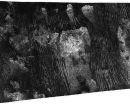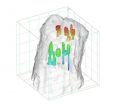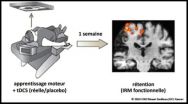(Press-News.org) As sand dunes march across the Sahara, vast dunes cross the surface of Saturn's largest moon, Titan. New research from a refurbished NASA wind tunnel reveals the physics of how particles move in Titan's methane-laden winds and could help to explain why Titan's dunes form in the way they do. The work is published online Dec. 8 in the journal Nature.
"Conditions on Earth seem natural to us, but models from Earth won't work elsewhere," said Bruce White, professor of mechanical and aerospace engineering at the University of California, Davis, and a co-author on the study. "This paper gives us the thresholds to work out what models for Titan would look like."
Earth's dunes are made of silica sand, while Titan's dunes, revealed by the Cassini space probe, are made of coated grains of crystalline water. Titan's atmosphere is 95 percent nitrogen, 5 percent methane and about half again as thick as that of Earth.
When a fluid flows over a layer of particles, there is a threshold speed at which the particles start to move. On Earth, air blowing over sand will start to kick up grains when it reaches a wind speed of about 4 meters per second. But flowing water, which is closer in density to silica, will move sand at much lower speeds.
White and colleagues used a wind tunnel in the Planetary Aeolian Laboratory at NASA's Ames Research Center to establish threshold wind speeds at which grains would start to move on Titan. They found that the threshold was higher than predicted from models based on terrestrial systems.
They were able to reconcile their experiments with the models by allowing for the low ratio of density between particles and atmosphere on Titan.
The new results should help in understanding atmospheric forces on other icy moons and planets with very thin or thick atmospheres, such as Neptune's moon Triton, Pluto or on comets. They can also help us better understand movement of particles in fluids in general. Particle flows are important in a wide range of situations, including coal-mine or grain-elevator dust explosions, environmental pollution and lubricants.
For White, it's a return to work he did almost 40 years ago, before joining the faculty at UC Davis. After completing his doctoral research at Iowa State University on the physics of Martian dust storms, White helped the late Ron Greeley at NASA Ames build a wind tunnel for research on Mars and Venus, which became known as the Planetary Aeolian Laboratory. The facility was mothballed in the mid-1980s, but recently refurbished by a group led by Devon Burr at the University of Tennessee-Knoxville, who is first author on the Nature paper.
"It's very pleasing to be able to hand this on to a new generation of researchers," White said.
INFORMATION:
Other co-authors on the paper are: Nathan Bridges, Johns Hopkins University; John Marshall, SETI Institute, Mountain View; James Smith, Arizona State University; and Joshua Emery, University of Tennessee-Knoxville. The work was supported by NASA.
ATLANTA - December 9, 2014- A new American Cancer Society study finds that despite significant drops in smoking rates, cigarettes continue to cause about three in ten cancer deaths in the United States. The study, appearing in the Annals of Epidemiology, concludes that efforts to reduce smoking prevalence as rapidly as possible should be a top priority for the U.S. public health efforts to prevent cancer deaths.
More than 30 years ago, a groundbreaking analysis by famed British researchers, Richard Doll and Richard Peto, calculated that 30 percent of all cancer deaths ...
Whether we're paying attention to something we see can be discerned by monitoring the firings of specific groups of brain cells. Now, new work from Johns Hopkins shows that the same holds true for the sense of touch. The study brings researchers closer to understanding how animals' thoughts and feelings affect their perception of external stimuli.
The results were published Nov. 25 in the journal PLoS Biology.
"There is so much information available in the world that we cannot process it all," says Ernst Niebur, Ph.D., a professor of neuroscience in the Johns Hopkins ...
LIVERMORE, Calif. -- Large-scale storage of low-pressure, gaseous hydrogen in salt caverns and other underground sites for transportation fuel and grid-scale energy applications offers several advantages over above-ground storage, says a recent Sandia National Laboratories study sponsored by the Department of Energy's Fuel Cell Technologies Office.
Geologic storage of hydrogen gas could make it possible to produce and distribute large quantities of hydrogen fuel for the growing fuel cell electric vehicle market, the researchers concluded.
Geologic storage solutions ...
Neuro-rehabilitation (physical therapy, occupational therapy, etc.) helps hemaparetic stroke patients confronted with loss of motor skills on one side of their body, to recover some of their motor functions after a cerebrovascular accident. One of the most promising tracks in neuro-rehabilitation consists in amplifying the motor learning ability after a stroke, in other words how to learn (again) how to make movements with the parts of the human body impacted after a stroke.
Pilot studies have shown at this matter that tDCS (transcranial direct current stimulation) - ...
Nidelric pugio fossil dates to half a billion years ago and teaches us about the diversity of life in Earth's ancient seas
In life the animal was a 'balloon' shape and was covered in spines, but the squashed fossil resembles a bird's nest
Named in honour of Professor Richard Aldridge from the University of Leicester
A rare 520 million year old fossil shaped like a 'squashed bird's nest' that will help to shed new light on life within Earth's ancient seas has been discovered in China by an international research team - and will honour the memory of a University of ...
Montreal, Canada, November x, 2014 - Angiochem, a clinical stage biotechnology company creating and developing drugs that cross the blood-brain barrier, today announced the publication in Molecular Cancer Therapeutics demonstrating that ANG4043, a peptide-monoclonal antibody (mAb) conjugate, entered the brain at therapeutic concentrations, resulting in significantly prolonged survival in mice. The antibody is directed against HER2, which is the protein targeted by Herceptin®. Because the mAb is conjugated to Angiopep-2, it is recognized by the LRP1 receptor and takes ...
Phoenix, AZ (December 9th, 2014) - Healthy, elderly research participants who report being more sleepy and less rested have higher levels of amyloid deposition in regions of the brain that are affected in Alzheimer's disease, according to a report presented today at the American College of Neuropsychopharmacology annual meeting in Phoenix (Arizona). If sleep disturbance is a cause of amyloid accumulation, it may be an early target for intervention to prevent the progression of cognitive deficits in late life.
Numerous studies have shown the importance of sleep and the ...
Phoenix, AZ (December 9th, 2014) - Abnormalities in the prefrontal cortex and related brain areas are observed in adolescents who have attempted suicide, according to a report today at the American College of Neuropsychopharmacology annual meeting in Phoenix Arizona. The study suggests that deficits in frontal systems may be associated with risk for suicide attempts in youths with mood disorders.
Most suicide attempts occur in the context of mood disorders, including bipolar disorder and major depressive disorder. Bipolar disorder has a prevalence of 3-4% in the U.S. population, ...
A multicenter phase 1 trial of the immune checkpoint blocker ipilimumab found clinical benefit in nearly half of blood cancer patients who had relapsed following allogeneic stem cell transplantation, according to investigators from Dana-Farber Cancer Institute, who developed and lead the study.
The study reported at the American Society of Hematology annual meeting is the first in which ipilimumab was given in multiple doses over an extended time period, the researchers said.
At a median follow-up time of six months, "We have seen less toxicity than expected and a strong ...
A study that investigated the potential of the compound PRM-151 (PRM) for reducing progressive bone marrow fibrosis (scarring) in patients with advanced myelofibrosis has shown initial positive results. Myelofibrosis is a life-threatening bone marrow cancer.
The study, led by Srdan Verstovsek, M.D., Ph.D., professor of leukemia at The University of Texas MD Anderson Cancer Center, showed the compound was well tolerated in observing 27 patients. Verstovsek's research results were presented today at the 56th Annual Meeting of the American Society of Hematology (ASH) annual ...




